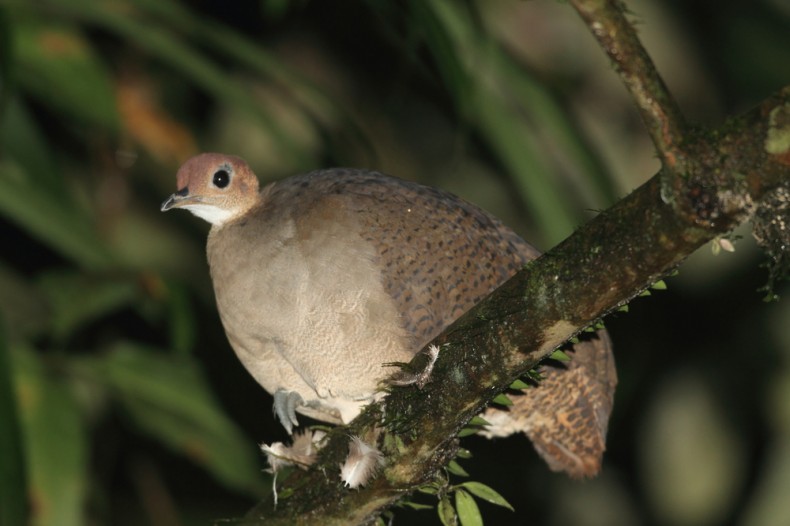Three years ago, I spent a while in the rainforest of Panama, for a story. It’s one of those swashbuckling freelancer stories, except—like so many of those—it’s not all that swashbuckling when you get down to the details. I was an hour’s drive (on good roads) from an international airport. I was staying in a comfortable B&B in the town of Gamboa, which was carved out of the rainforest to house the Panama Canal’s dredging division. But the rainforest is still right there; you have the sense that if anyone left their house empty for too long, moss would grow, vines would come in the windows, and monkeys would set up housekeeping.
I was there to hang around with a biologist who studies frog reproduction. I combined the work with a family vacation; my parents came along for some sightseeing and nature before I started my reporting. On our first full day in Gamboa, we went out with a local guide who had a spotting scope and much experience with visiting birders. We saw dozens of species–green birds, red birds, yellow birds, black birds. The red-legged honeycreeper. The slaty-tailed trogon.
As we walked back toward the car, our guide stopped abruptly. Against the background of singing insects and chirps from the treetops, a haunting whistle rose. Its long, warm notes came through the dense growth at the edge of the road. He told us its name: the great tinamou.
You may imagine that tropical birds are all glamorous, exciting, flashy birds. Not the great tinamou. It is chicken-sized and brown. It lives in the rainforests of the Americas, from Mexico to the Amazon. On the IUCN Red List, the international list of threatened and endangered species, they’re classified as “near threatened.” That’s a pretty good rating—they aren’t threatened—but it reflects a common danger. As with so many other species, if the rainforest is cut down, they’re homeless, and homeless is dead.
The guide whistled and the bird whistled back. But he couldn’t get it to show itself. My bird book said, accurately, that this bird is “far more often heard than seen.” We gave up.
Later in the week, I took a side trip to Barro Colorado Island. It used to be a hill along the Chagres River, which was dammed to form the middle stretch of the canal. Now the six-square-mile island is a major center for research.
In the rainforest, all the sun and most of the action are up in the canopy. Trees spread their leaves, monkeys pick fruit, and birds flap and call. On the ground, it’s dark and still. I wound upward on uneven steps. The dark forest floor was dotted with brightly-colored plastic flags on stakes, the universal marker of field ecology. Leafcutter ants traversed well-worn paths, toting oversized chunks of greenery they’d hauled down from the canopy. Here and there a fallen tree had left a gap, filled with seedlings and saplings vying for a spot in the sun.
As I walked down the valley, I heard a familiar, sweet call. A few yards down from me, a pair of great tinamous stepped onto the trail. They caught sight of me and froze. They looked at me. I looked at them. After a moment, they must have decided I wasn’t a threat. They poked along the trail, calling softly back and forth.
Tinamous are related to ostriches and rheas. Unlike those birds, they can fly if they have to, but they prefer to walk. These walked, looked around, even sat down on the trail. After more than 10 minutes of this, they strolled off into the forest, calling gently to each other.
My approach to birding has always been pretty lackadaisical. I used to keep a life list, but I lost track. I’ve seen new species mostly by going to far-off lands. I picked up the laughing kookaburra, the sulphur-crested cockatoo, and dozens of others on a trip to Australia. From a boat in the Bering Sea, I saw tufted puffins and a McKay’s bunting.
When I visited Saudi Arabia earlier this summer, I reveled in the hoopoes—and was disappointed when I got home and realized, no matter how long I walked, I was never going to see that black-white-and-tan body cruise by. At home, I get a different treat: northern mockingbirds, proudly cycling through one imitated song after another like a nature enthusiast’s car alarm. In Sweden last year, I was excited to see the bullfinches—which I’d first encountered 16 years earlier while living in Norway.
These different species act like little flags, telling me where in the world I am, reminding me of past visits and flights. Most wild mammals will do their best to hide. It’s the birds, swooping or walking in and out of my life, that really tell me where I am.

“Chicken-sized” and “I used to keep a life list, but I lost track” that was funny 🙂
Entirely Interesting .
I hope to have the ability to write as wonderful essays as yours .
Best wishes ,
Shatha